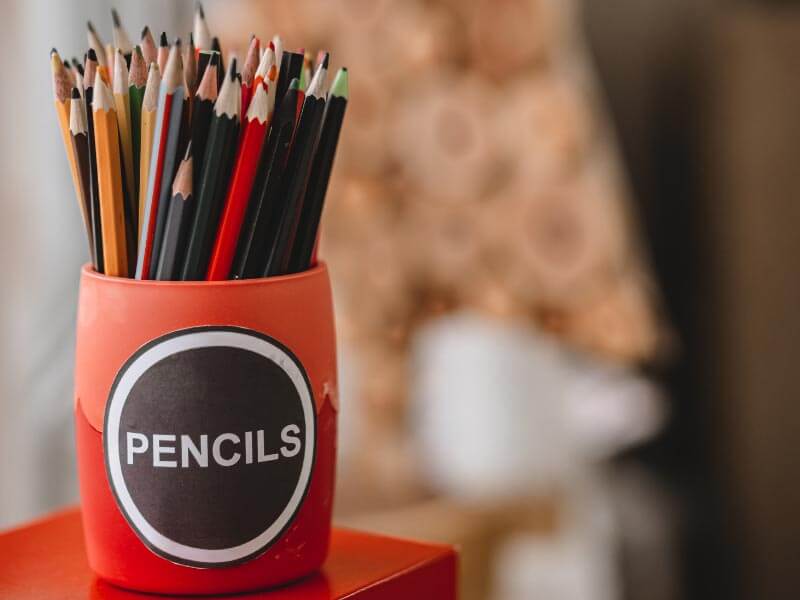Most people’s first experiences with art are with pencils, as they are among the most common and most accessible art supplies. Though the #2 standard pencils will get you far in life, you’ll need more specialized tools if you want to make a living as a pencil artist. This is because picking the right pencils makes a huge difference in the final product.
Different pencils offer different degrees of hardness, degrees of blackness, and textures, giving you a wide range of options for expressing your creativity. If you use the wrong pencil for your drawing, you might not get the results you were hoping for. Lucky for you, this article will explain the differences between the variety of pencils you may use to realize your artistic goals.
Charcoal Pencils
These are famous for their capacity to produce deep, dramatic blacks because they’re crafted from compressed charcoal. They may create highly contrasted, nuanced tones as well. Charcoal pencils generally fall in the HB to 6B hardness range. For this reason, you can effectively use them to create faceless self portraits. The lead in this pencil is weaker than in others, and it smudges readily. If you do make a mistake, though, you can simply rub it off or fade it away.
Graphite Pencils
Most pencil leads are constructed from a clay and graphite blend, and this is the most prevalent variety. It is available in a range of grades, each of which describes the material’s relative hardness or darkness. They are represented by the H and B, respectively. Since H pencils are made with more filler and less graphite, they are tougher but draw lighter lines. However, B-grade pencils are softer and don’t have as much filler, so they produce a darker mark.
Within each class, the lead’s hardness or softness is quantified by a set of numbers. As the category number climbs in the H set, the density decreases, making each successive pencil lighter and lighter. The grades range from the simplest H, the 1H, through the most complex H, the 6H. As the numbers increase, though, the B category becomes more ominous. Number one is represented by the B pencil. The next pencil is a 2B, then a 3B, then a 4B, and so on, all the way up to a 12B.
Liquid Graphite Pencil
With this pencil, you may use a liquid medium to imitate the look of traditional graphite pencils and make realistic pencil sketches. The liquid pencil must be applied to the paper with a brush.
Liquid pencils from Derivan are among the most well-liked. Derivan offers us a total of six colors to work with: red, blue, yellow, grey3, and grey9.
Carbon Pencils
It’s a charcoal and graphite hybrid, which is what makes this pencil so special. Drawing with this kind of pencil facilitates the use of blending methods and the incorporation of texture all at once. They also take on a new shade when combined with charcoal or graphite.They’re darker than regular pencils but less gritty than charcoal ones. The heavy lines they leave, however, aren’t always easy to get rid of.
Grease Pencils
This is a special kind of pencil that is made of cured colored wax. Sometimes called a chinagraph pencil, china marker, or wax pencil. They’re capable of writing on virtually any surface with minimal damage. For this reason, it is ideal for marking on nonporous, hard materials including porcelain, glass, granite, polished stone, plastic, metal, and more.
Many laboratories keep this particular pencil on hand so that glassware may be properly labeled. It’s also a useful marking tool for plumbers and handymen during building and remodeling projects.
Mechanical Pencils
In the same way that a ballpoint pen has a plastic or metal body, a mechanical pencil does too. Mechanical pencils have a mechanism at the end that forces the lead through the opening. Like regular graphite pencils, the leads for these specialized pencils come in a range of sizes and opacities. Thus, they find primary function in the writing and engineering arts. Moreover, these pencils include interchangeable graphite cartridges that can be refilled to provide a longer writing life.
Colored Pencils
These artistic tools are crafted from a variety of materials such as colored pastels, charcoal, chalk, and more. These multipurpose supplies, which come in a rainbow of colors, let you create everything from simple sketches to elaborate works of art. And because of their accessibility and lack of mess, they are useful not just in the world of fine art but also among youngsters.
You’ll notice that colored pencils have a different grading system than regular pencils. There is no standard HB grade for colored pencils like there is for standard pencils. Instead, the degree to which they are soft or firm depends on the brand you choose.
Watercolor Pencils
These are also known as water-soluble pencils, a flexible painting media that may be activated with a brush and water to create a splash of color. To get the watercolor appearance, the dried pigment must be laid down first, and then dip the paintbrush into the water. There are some 120-color sets of artist-grade watercolor pencils, although the most common sets include 60 or 72 colors.
Final Words
Before embarking on your artistic journey of drawing or sketching, it is crucial to possess a fundamental comprehension of pencils. Planning ahead and identifying the necessary resources for your project is a wise and strategic approach to ensure its successful completion.

